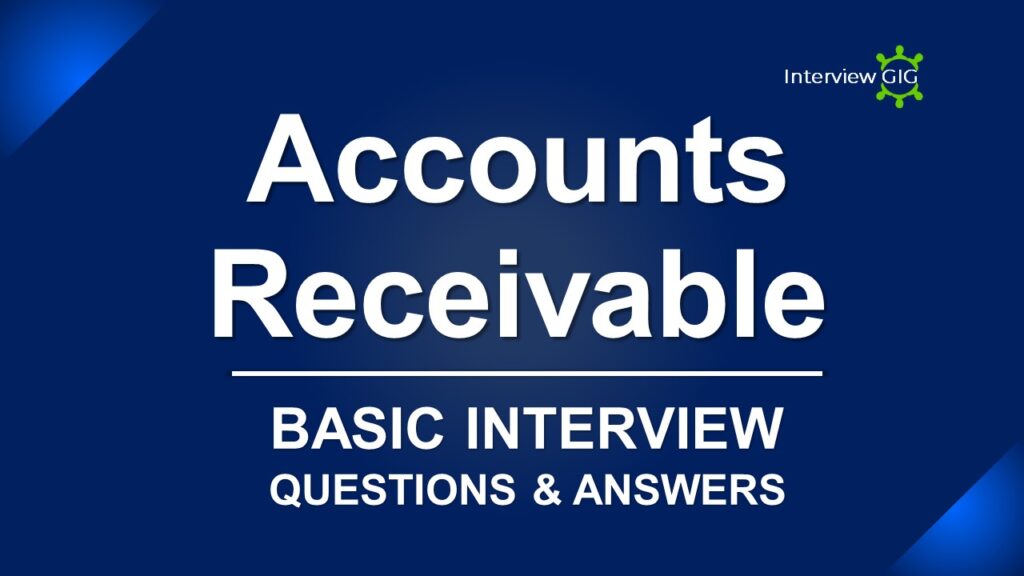Junior Accountant Interview Questions
Navigating the world of accounting can be both exciting and challenging, especially for freshers and experienced candidates preparing for interviews in this dynamic field. Whether you’re stepping into your first role or looking to advance your career, understanding key concepts and being well-prepared for common interview questions is essential.
In this article, we will delve into a variety of essential topics related to accounting and financial management, including:
- Financial Accounting: Understanding the principles and practices that govern financial reporting.
- Reconciliation: Exploring the methods and importance of reconciling accounts to ensure accuracy.
- Accounts Payable & Receivable: Learning the processes involved in managing incoming and outgoing payments effectively.
- Tally Software: Gaining proficiency in using Tally for streamlined accounting tasks.
- Bookkeeping: Mastering the fundamentals of recording financial transactions accurately.
- General Ledger: Understanding how to maintain and manage the general ledger for financial reporting.
- Goods and Services Tax (GST): Staying updated on GST regulations and their impact on accounting practices.
- Tax Preparation: Learning the steps involved in preparing and filing taxes correctly.
- Payroll Processing: Understanding the payroll cycle and how to manage employee compensation efficiently.
- Compliance Regulations: Familiarizing yourself with the compliance requirements in accounting.
- Invoicing: Learning how to create and manage invoices effectively.
- Registrar of Companies (ROC) & Investor Relations (IROC): Understanding the roles of ROC and IROC in corporate governance and compliance.
By familiarizing yourself with these areas, you can boost your confidence and enhance your chances of success in your upcoming interviews.
First Topic is Accounting and Financial Accounting
Question: What accounting principles do you follow in your work?
Sample Answer: I follow generally accepted accounting principles (GAAP) to ensure consistency and accuracy in financial reporting. These principles guide my work in recording transactions, preparing financial statements, and maintaining accurate records.
Question: What is your experience with financial accounting?
Sample Answer: My experience includes managing financial transactions, preparing financial statements, and ensuring compliance with accounting standards. I have worked on various aspects of financial accounting, such as journal entries, reconciliations, and financial reporting.
Question: What are the basic accounting principles?
Sample Answer: Basic Accounting Principles
Accounting principles are the fundamental rules and guidelines used to record and report financial information. They ensure consistency, reliability, and comparability of financial statements. Some key principles include:
- Accrual Principle: This principle states that revenues and expenses should be recorded when earned or incurred, respectively, regardless of when cash is received or paid.
- Matching Principle: Expenses should be matched with the revenues they helped generate in the same accounting period.
- Revenue Recognition Principle: Revenue should be recognized when it is earned, regardless of when cash is received.
- Cost Principle: Assets should be recorded at their original cost.
- Going Concern Principle: It is assumed that a business will continue to operate indefinitely.
- Consistency Principle: Accounting methods and principles should remain consistent over time.
- Full Disclosure Principle: All relevant financial information should be disclosed in the financial statements.
- Materiality Principle: Only significant items that could influence a user’s decision should be disclosed.
Question: What is the difference between accrual and cash basis accounting.
Sample Answer: Accrual Basis Accounting: Revenue and expenses are recorded when they are earned or incurred, regardless of when cash is exchanged. Provides a more accurate picture of a company’s financial position and performance.
Cash Basis Accounting: Revenue and expenses are recorded only when cash is received or paid. Simpler and easier to implement but may not accurately reflect the true financial position of a company.
Question: How do you maintain ethical standards in accounting?
Sample Answer: Ethical standards are crucial for maintaining the integrity of financial reporting. Key principles include:
- Honesty and Integrity: Accountants should be truthful and trustworthy in their work.
- Objectivity: Accountants should avoid bias and conflicts of interest.
- Competence: Accountants should possess the necessary knowledge and skills to perform their duties.
- Confidentiality: Accountants should protect confidential information.
- Professional Behavior: Accountants should comply with professional standards and regulations.
Question: What is the concept of revenue recognition.
Sample Answer: Revenue recognition is the accounting principle that outlines the specific conditions under which revenue is recognized. Generally, revenue is recognized when:
- The revenue is earned, which usually means that a product has been delivered or a service has been performed.
- The amount of revenue can be reasonably measured.
- It is probable that the economic benefits associated with the transaction will flow to the entity.
- The costs incurred or to be incurred in respect of the transaction can be measured reliably.
Question: How do you prepare financial statements for external users?
Sample Answer: Financial statements are prepared to provide information about a company’s financial performance and position to external users such as investors, creditors, and regulators. The primary financial statements are:
Income Statement: Shows the company’s revenues, expenses, and net income for a specific period.
Balance Sheet: Presents a snapshot of a company’s financial position at a specific point in time, showing assets, liabilities, and equity.
Cash Flow Statement: Reports the company’s cash inflows and outflows from operating, investing, and financing activities.
Statement of Retained Earnings: Shows the changes in retained earnings over a specific period.
Reconciliation
Question: What is reconciliation and why is it important?
Sample Answer:
Reconciliation: The process of ensuring that two sets of records (e.g., a company’s cash book and a bank statement) are in agreement. It involves identifying and explaining differences between them.
Importance:
- Helps in identifying errors, fraud, or omissions.
- Ensures accurate financial reporting.
- Provides assurance that the company’s financial records are correct and complete.
Question: Can you explain the reconciliation process you follow?
Sample Answer: The reconciliation process involves comparing the company’s internal records with external statements from banks or other financial institutions. I review all transactions, match them to ensure accuracy, and identify discrepancies. For discrepancies, I investigate the cause and make necessary adjustments.
Question: How do you handle discrepancies found during reconciliation?
Sample Answer: When I find discrepancies, I review supporting documents, such as invoices and receipts, to identify the error. I then correct the records and document the discrepancy to prevent future issues. If needed, I communicate with the relevant parties to resolve the issue.
Question: Explain the process of bank reconciliation.
Sample Answer:
Process of Bank Reconciliation
- Collect Records: Gather the company’s cash book and the bank statement for the same period.
- Compare Balances: Compare the ending balance in the cash book with the ending balance on the bank statement.
- Identify Discrepancies: Look for differences between the two balances caused by timing differences or errors.
- Adjust for Outstanding Items: Adjust the cash book for outstanding checks (issued but not cleared) and deposits in transit (deposits made but not yet recorded by the bank).
- Reconcile the Balances: After adjustments, the adjusted cash book balance should match the bank statement balance. Document the reconciliation process.
Question: How do you handle outstanding checks and deposits in transit during bank reconciliation?
Sample Answer:
Outstanding Checks: Subtract the number of amount outstanding checks from the bank statement balance since these checks have been issued but not yet cleared by the bank.
Deposits in Transit: Add the amount of deposits in transit to the bank statement balance since these have been recorded in the cash book but not yet processed by the bank.
Question: What is the difference between a cash book and a bank statement?
Sample Answer:
Cash Book: A financial journal that records all cash receipts and payments, including bank deposits and withdrawals. Maintained by the company and reflects all transactions from the company’s perspective.
Bank Statement: A record provided by the bank that shows all transactions in and out of the company’s bank account during a specific period. Reflects the bank’s records of the company’s transactions.
Question: How would you handle discrepancies found during bank reconciliation?
Sample Answer:
Discrepancies can arise due to various reasons:
- Bank errors: Contact the bank to resolve.
- Timing differences: Adjust for outstanding checks, deposits in transit, etc.
- Book errors: Correct errors in the cash book.
- Unrecorded transactions: Record missing transactions in the cash book.
Question: Explain the process of reconciling credit card statements.
Sample Answer:
Credit card reconciliation is similar to bank reconciliation, but involves comparing credit card statements with the company’s records. The process includes:
- Matching charges on the statement with company records.
- Identifying discrepancies and investigating their causes.
- Recording adjustments to the credit card account.
Question: What are the common challenges faced during account reconciliation?
Sample Answer:
Common challenges include:
- High volume of transactions: Can be time-consuming.
- Human error: Mistakes in recording transactions.
- System errors: Issues with accounting software or bank systems.
- Fraudulent activities: Unauthorized transactions.
Question: What is the difference between bank reconciliation and account reconciliation?
Sample Answer:
Bank Reconciliation: Specifically compares the company’s cash book with its bank statement to ensure they match. Focuses on cash and bank transactions.
Account Reconciliation: A broader term that applies to reconciling any general ledger account, such as accounts receivable, accounts payable, or inventory. Involves matching internal records with external documents or third-party statements.
Question: How do you prioritize accounts for reconciliation?
Sample Answer:
High-Value Accounts: Focus on accounts with large balances or frequent transactions, as errors here can significantly impact financial statements.
Critical Accounts: Reconcile accounts that are essential to the business’s operations, such as cash, accounts receivable, and accounts payable.
Aging Accounts: Give priority to accounts that have not been reconciled for a long time or have known issues.
Regulatory Requirements: Prioritize accounts that are subject to regulatory scrutiny or audit requirements.
Question: What steps would you take to reconcile an account with a large number of transactions?
Sample Answer:
Break down transactions: Analyze large transactions for accuracy.
Use reconciliation software: Automate the process.
Implement strong internal controls: Prevent errors and fraud.
Regular reviews: Conduct frequent reconciliations.
Accounts Payable & Accounts Receivable
Question: What is the process of accounts payable?
Sample Answer:
Process of Accounts Payable:
- Receive invoices from vendors.
- Verify invoices for accuracy and approval.
- Record invoices in the accounting system.
- Prepare payments to vendors.
- Reconcile accounts payable periodically.
Question: How do you handle vendor invoices?
Sample Answer:
- Receive invoices promptly upon receipt of goods or services.
- Verify details like quantity, price, and terms.
- Obtain necessary approvals for payment.
- Record invoices in the accounts payable system.
- Schedule payments based on due dates or terms.
Question: Explain the concept of invoice discounting?
Sample Answer:
Invoice discounting involves a company selling its accounts receivable (invoices) to a third-party financial institution (like a bank) at a discount.
The company receives immediate funds (less the discount) rather than waiting for customers to pay their invoices.
Question: What is the process of accounts receivable?
Sample Answer:
- Issue invoices to customers for goods or services provided.
- Track and record accounts receivable in the accounting system.
- Monitor payment due dates and follow up on overdue invoices.
- Receive payments from customers and record them.
- Reconcile accounts receivable periodically.
Question: How do you manage customer credit limits?
Sample Answer:
- Set credit limits based on the customer’s creditworthiness and history.
- Regularly review and update credit limits as needed.
- Monitor customer payment behaviour and credit utilization.
- Use credit management tools to assess risks and manage exposure.
Question: What is bad debt expense?
Sample Answer:
Bad debt expense is an expense incurred when a customer defaults on payment, and the company determines the debt is uncollectible.
It reflects the portion of accounts receivable that the company does not expect to recover
Question: How do you handle customer disputes?
Sample Answer:
- Promptly address customer concerns or complaints.
- Investigate the issue thoroughly, involving relevant departments if needed.
- Seek a resolution that is fair and acceptable to both parties.
- Document the resolution process and follow up to ensure satisfaction.
Question: What is the difference between factoring and invoice discounting?
Sample Answer:
Factoring: Involves selling accounts receivable to a third-party (factor) at a discount. The factor manages credit control and collects payments directly from customers.
Invoice Discounting: Involves using invoices as collateral to obtain a loan or cash advance from a financial institution. The company retains control over credit management and customer relationships.
Tally software
Question: What is Tally accounting software?
Sample Answer: Tally is a comprehensive accounting software widely used for financial accounting, inventory management, and compliance tasks, developed by Tally Solutions Pvt Ltd.
Question: What are the basic functions of Tally?
Sample Answer: Basic Functions of Tally
Financial Accounting: Manages bookkeeping, ledger entries, and financial transactions.
Inventory Management: Tracks stock levels, purchases, and sales of inventory items.
Taxation: Facilitates GST compliance, including calculation, recording, and filing of GST returns in India.
Banking: Supports bank reconciliation, cash management, and cheque printing.
Reporting: Generates financial reports like balance sheets, profit and loss statements, and cash flow statements.
Question: How do you use Tally for generating financial reports?
Sample Answer: Using Tally for Generating Financial Reports
Data Entry: Input all financial transactions accurately into Tally.
Ledger Maintenance: Keep ledger accounts updated with transactions.
Report Generation: Navigate to report menus (e.g., Balance Sheet, Profit and Loss), select parameters, and customize formats.
Printing or Exporting: Print reports or export them in formats like PDF or Excel for analysis and distribution.
Review and Analysis: Review reports for accuracy and use them to analyze financial performance and make business decisions.
Bookkeeping
Question: What bookkeeping methods do you prefer and why?
Sample Answer: I prefer the double-entry bookkeeping method because it ensures accuracy by recording each transaction twice, once as a debit and once as a credit. This method helps maintain balanced books and provides a clear audit trail.
Question: What is the difference between single-entry and double-entry bookkeeping?
Sample Answer:
Single-Entry Bookkeeping: Records each transaction as a single entry, typically in a simple format like a cash book. It doesn’t maintain a balance for each account.
Double-Entry Bookkeeping: Records each transaction with at least two entries: a debit to one account and a credit to another, ensuring that total debits equal total credits. It provides a complete financial picture and supports accuracy checks.
Question: Explain the basic accounting equation?
Sample Answer:
Assets = Liabilities + Equity
It shows that assets (what the company owns) are financed by either liability (what the company owes) or equity (owner’s investment in the business).
Question: How do you ensure accuracy and completeness in bookkeeping?
Sample Answer:
- Use standardized processes and accounting principles (GAAP or IFRS).
- Reconcile accounts regularly to detect and correct errors promptly.
- Maintain supporting documentation for all transactions.
- Implement internal controls to prevent and detect errors or fraud.
- Regularly review financial statements for accuracy and completeness.
Question: How do you handle errors in bookkeeping?
Sample Answer:
- Identify the error through reconciliation or review.
- Determine the type of error (e.g., transposition, omission).
- Correct the error by adjusting the affected accounts.
- Document the correction with an explanation.
Question: What is the normal balance of assets, liabilities, and equity accounts?
Sample Answer: In accounting, the normal balance of accounts is as follows:
Assets: Debit (Dr)
Liabilities: Credit (Cr)
Equity: Credit (Cr)
This means that asset accounts typically have a debit balance, while liability and equity accounts usually have a credit balance. This applies in India, as well as in most accounting systems globally.
Question: What is the difference between debit and credit?
Sample Answer:
Debit: Represents an increase in assets or expenses, or a decrease in liabilities or revenue.
Credit: Represents an increase in liabilities or revenue, or a decrease in assets or expenses.
General Ledger & Balance Sheets
Question: What is the purpose of a general ledger?
Sample Answer: The purpose of a general ledger is to serve as the central repository for all financial transactions of a business. It records and categorizes all entries into accounts, providing a complete and accurate summary of the company’s financial activities. The general ledger is essential for preparing financial statements, tracking financial health, and ensuring accurate financial reporting.
Question: What is your experience with maintaining the general ledger?
Sample Answer: I have extensive experience maintaining the general ledger, including posting journal entries, reconciling accounts, and ensuring accuracy in financial reporting. I regularly review the ledger to ensure all transactions are recorded correctly and make adjustments as needed.
Question: How do journal entries affect the general ledger?
Sample Answer:
Journal entries record individual transactions with debits and credits in the general ledger. Each entry updates the respective accounts, reflecting changes in financial positions such as assets, liabilities, and equity. These updates accumulate in the general ledger to provide a complete record of all transactions.
Question: Explain the process of closing the general ledger at the end of an accounting period?
Post Transactions: Ensure all transactions for the period are recorded and posted to the general ledger.
Prepare Trial Balance: Generate a trial balance to verify that debits equal credits.
Adjust Entries: Record any adjusting entries for accruals, deferrals, or corrections.
Close Temporary Accounts: Transfer balances from revenue and expense accounts to retained earnings or capital accounts to prepare for the next period.
Generate Financial Statements: Prepare financial statements like the income statement and balance sheet based on the updated general ledger.
Roll Forward Balances: Carry forward the ending balances of permanent accounts (assets, liabilities, equity) to the new accounting period.
Balance sheets
Question: What is your process for preparing a balance sheet?
Sample Answer: I prepare a balance sheet by gathering data on assets, liabilities, and equity, ensuring all transactions are recorded and reconciled. I categorize and verify each item, calculate totals, and ensure the balance sheet balances.
Question: How do you ensure the accuracy of balance sheet figures?
Sample Answer: I ensure accuracy by performing reconciliations, cross-checking figures with supporting documents, and conducting variance analysis. I also review the balance sheet for compliance with accounting standards and consistency with other financial statements.
Question: Describe an issue you encountered while preparing a balance sheet and how you resolved it.
Sample Answer: I encountered discrepancies in fixed asset records. I conducted a thorough review, identified misclassifications and recording errors, and updated the asset register. Regular communication with the asset management team helped resolve the issue.
Question: What is the difference between debit and credit?
Sample Answer:
Debit: Represents an increase in assets or expenses, or a decrease in liabilities or revenue.
Credit: Represents an increase in liabilities or revenue, or a decrease in assets or expenses.
GST & GST Return
Question: What is GST (Goods and Services Tax)?
Sample Answer:
GST is a comprehensive, multi-stage, destination-based tax that has replaced multiple indirect taxes in India. It is levied on the supply of goods and services.
Importance of GST:
One Nation, One Tax: Simplified tax structure.
Reduced cascading effect: Eliminated multiple taxation.
Increased tax base: Improved tax compliance.
Boost to economy: Facilitated ease of doing business.
Components of GST:
- CGST (Central Goods and Services Tax): Collected by the Central Government on intra-state supplies.
- SGST (State Goods and Services Tax): Collected by State Governments on intra-state supplies.
- IGST (Integrated Goods and Services Tax): Collected by the Central Government on inter-state supplies or imports.
- UTGST (Union Territory Goods and Services Tax): Collected by Union Territory Governments on intra-UT supplies.
Question: How is GST calculated and filed?
Sample Answer:
Calculation: GST is calculated on the value of goods or services supplied. The rate varies based on the product or service.
GST is filed online through the GST portal (gst.gov.in).
Monthly or quarterly returns are filed depending on the turnover.
Steps include preparing invoices, uploading them to the GST portal, and filing GSTR-1 (outward supplies), GSTR-3B (summary return), and GSTR-9 (annual return).
Question: How do you calculate GST liability?
Sample Answer:
Determine the GST rate applicable to your goods or services (e.g., 5%, 12%, 18%, or 28%).
GST Liability=Taxable Value × (GST Rate /100 )
Question: How do you prepare and file GST returns?
Sample Answer: I prepare GST returns by reviewing sales and purchase records, calculating GST liability, and reconciling GST accounts. I ensure all transactions are correctly classified and submit the returns within specified deadlines
Question: What are the different types of GST returns?
Sample Answer:
GSTR-1: Monthly or quarterly return for outward supplies made by the taxpayer.
GSTR-3B: Monthly summary return of inward and outward supplies, along with tax payment.
GSTR-4: Quarterly return for composition scheme taxpayers.
GSTR-9: Annual return filed by regular taxpayers.
GSTR-9C: Reconciliation statement and audit report for taxpayers above a certain turnover.
Question: What are the common GST compliance challenges?
Sample Answer:
Common GST Compliance Challenges
Complexity: Understanding and applying GST rates correctly.
IT Infrastructure: Issues with the GSTN portal and technology readiness.
Classification: Correctly classifying goods and services under the correct GST rate.
Input Tax Credit (ITC): Proper documentation and reconciliation of ITC.
Timely Filing: Meeting deadlines for GST filing and payment.
Transition Issues: Challenges during the transition from the old tax regime to GST.
Question: What challenges have you faced with GST compliance, and how did you overcome them?
Sample Answer: I faced challenges with frequent regulatory changes. To overcome this, I stayed updated through training sessions, industry publications, and regular consultations with tax advisors. This ensured accurate and compliant GST filings.
Question: How do you handle discrepancies in GST returns?
Sample Answer: I investigate discrepancies by reviewing transaction records, matching invoices with entries, and ensuring correct GST classifications. I make necessary adjustments and communicate with suppliers or customers if needed to resolve issues.
Tax Return & Tax Preparations
Question: Explain the concept of TDS and TCS?
Sample Answer:
TDS (Tax Deducted at Source): Tax deducted by the payer (employer, bank, etc.) at the time of making a payment to the payee (employee, contractor, etc.). Examples include TDS on salary, interest, rent, etc.
TCS (Tax Collected at Source): Tax collected by the seller from the buyer at the time of sale of specified goods or services. Examples include TCS on sale of property, luxury goods, etc.
Question: How do you prepare for tax season?
Sample Answer: I prepare for tax season by organizing all necessary financial records throughout the year, staying updated on tax laws and regulations, and ensuring all transactions are accurately recorded. I also review past tax returns to identify any changes or improvements needed.
Question: What is the difference between direct and indirect taxes?
Sample Answer:
Direct Taxes:
- Levied directly on an individual’s or organization’s income or wealth.
- The burden of the tax cannot be shifted to another party.
- Examples: Income Tax, Corporate Tax, Wealth Tax.
Indirect Taxes:
- Levied on goods and services rather than on income or wealth.
- The burden of the tax can be shifted to another party, usually passed on to the end consumer.
- Examples: GST (Goods and Services Tax), VAT (Value Added Tax), Excise Duty.
Question: What are the common tax deductions for salaried employees?
Sample Answer:
Common Tax Deductions for Salaried Employees
- Section 80C: Investments in PPF, EPF, ELSS, NSC, etc.
- Section 80D: Medical insurance premiums
- Section 24: Home loan interest
- Section 80E: Education loan interest
- Section 80EE: Interest on home loan for first-time home buyers
- Section 80TTA/80TTB: Interest on savings bank and fixed deposits
- House Rent Allowance (HRA): Deduction for rent paid, subject to conditions.
Question: How do you handle GST Returns, PT, ESI, PF, and calculating employee TDS?
Sample Answer: I ensure compliance by accurately calculating and recording these transactions, maintaining detailed records, and filing returns on time. I stay updated on regulations to ensure accuracy and compliance.
GST Returns: Complex process involving input credit, output tax, returns filing (GSTR-1, GSTR-3B, etc.) on GST portal.
PT: Professional Tax calculation based on salary, deducted from employee pay, deposited to state government.
ESI & PF: Employer and employee contributions calculated on salary, deposited to respective government bodies.
TDS: Calculated on employee income exceeding tax exemption limit, deducted from salary, deposited to government.
Note: Requires understanding of tax laws, record-keeping, and use of accounting software.
Question: Describe your experience with tax preparation and filing.
Sample Answer: I have experience preparing and filing GST returns, calculating and remitting employee TDS, and ensuring compliance with PT, ESI, and PF regulations. I maintain accurate records and submit all filings within deadlines.
Payroll processing
Question: How do you handle payroll processing and ensure accuracy?
Sample Answer: I handle payroll processing by accurately entering employee data, calculating wages, and ensuring all deductions are applied correctly. I verify timesheets and payroll reports, and stay updated on labor laws and regulations to ensure compliance.
Question: What software have you used for payroll processing?
Sample Answer: I have used various payroll software, including Zoho Books and Tally, to process payroll. These tools help streamline the process, ensure accuracy, and maintain detailed records for compliance and reporting purposes.
Question: Explain the process of calculating employee salaries and deductions.
Sample Answer:
Process of Calculating Employee Salaries and Deductions:
- Determine gross salary based on agreed terms (basic salary, allowances, bonuses, etc.).
- Subtract statutory deductions like Provident Fund (PF), Employee State Insurance (ESI), and Income Tax (TDS) from gross salary to arrive at net salary.
Question: Explain the components of salary structure?
Sample Answer:
Basic Salary: Fixed component of salary, typically the largest part.
Allowances: Additional payments like house rent allowance (HRA), conveyance allowance, etc.
Bonuses and Incentives: Variable payments based on performance or company policies.
Question: How do you calculate deductions like PF, ESI, TDS?
Provident Fund (PF): Deducted at a fixed percentage of basic salary, both employer and employee contribute.
Employee State Insurance (ESI): Deducted at a fixed percentage of gross salary if applicable.
Income Tax (TDS): Deducted based on applicable tax slab rates after considering exemptions and deductions.
Question: What are the statutory requirements for payroll?
Sample Answer:
Payment of Wages Act: Ensures timely and accurate payment of wages.
Provident Fund (PF) Act: Mandates PF contributions for eligible employees.
Employee State Insurance (ESI) Act: Requires ESI contributions for employees in certain categories.
Income Tax Act: Specifies TDS deductions and reporting requirements.
Compliance
Question: What are the common accounting and tax compliance requirements?
Sample Answer:
Accurate Record-Keeping: Maintain detailed and accurate financial records of all transactions.
Financial Statements: Prepare and present financial statements (balance sheet, income statement, cash flow statement) as per accounting standards.
Tax Returns: File timely tax returns for income tax, VAT/GST, and other applicable taxes.
Audit Compliance: Ensure financial statements are subject to regular audits as required by regulations.
Documentation: Keep supporting documentation for transactions, deductions, and credits.
Regulatory Reporting: Comply with specific industry regulations and reporting requirements.
Question: How do you ensure compliance with accounting standards and regulations?
Sample Answer: I stay updated on relevant accounting standards and regulations by attending training sessions and reviewing industry updates. I apply this knowledge to my work, ensuring all financial transactions and records comply with the required standards.
Question: What are the key components of GST compliance?
Sample Answer: The key components of GST compliance include accurate record-keeping, timely filing of returns, proper calculation of GST liability, and ensuring all transactions are correctly classified. Regular reconciliation of GST accounts is also essential.
Invoicing
Question: How do you manage the invoicing process?
Sample Answer: I manage the invoicing process by generating accurate invoices, tracking their status, and following up on overdue payments. I use accounting software to automate and streamline the process, ensuring timely and accurate billing.
Question: What information is typically included in an invoice?
Sample Answer:
Information Typically Included in an Invoice
- Invoice Number: Unique identifier for the invoice.
- Date: Date of invoice issuance.
- Seller’s Details: Name, address, and contact information.
- Buyer’s Details: Name, address, and contact information.
- Description of Goods/Services: Detailed description of the items or services provided.
- Quantity and Unit Price: Quantity of goods or services and their unit price.
- Total Amount: Total amount due, including applicable taxes and discounts.
- Payment Terms: Payment due date and terms (e.g., net 30 days).
- Tax Information: Details of any applicable taxes (e.g., GST, VAT).
Question: Explain the process of creating and sending invoices?
Sample Answer:
Create Invoice: Use an invoice template or accounting software to input all required details.
Review: Check for accuracy and completeness.
Send Invoice: Deliver the invoice to the buyer via email, postal mail, or through an invoicing platform.
Track Payment: Monitor payment status and follow up as needed.
Question: What steps do you take if a customer disputes an invoice?
Sample Answer: If a customer disputes an invoice, I review the invoice and supporting documents, communicate with the customer to understand the issue, and resolve any errors. If the dispute is valid, I issue a corrected invoice or credit note.
ROS & IROC
Question: What is ROC (Registrar of Companies)?
Sample Answer: ROC is a government official or office responsible for overseeing the registration and regulation of companies and limited liability partnerships (LLPs) in India.
Question: What is the role of ROC in business registration?
Sample Answer: ROC handles the incorporation of companies, maintains a registry of companies, and ensures compliance with the Companies Act. It processes company registrations, changes in company details, and filings of annual returns.
Question: How does ROC interact with accounting and finance departments?
Sample Answer:
ROC requires companies to file financial statements, annual returns, and other compliance documents. The accounting and finance departments prepare these documents to meet ROC requirements and ensure legal compliance.
Question: What is IROC (Institute of Registered Accountants of India)?
Sample Answer:
IROC is not a recognized institution in India. You may be referring to ICAI (Institute of Chartered Accountants of India), which is the national professional accounting body in India.
Question: What are the benefits of becoming an IROC member?
Sample Answer:
Professional Recognition: Gain credibility and recognition as a qualified accountant.
Career Opportunities: Access to a wide range of career and networking opportunities.
Continual Learning: Opportunities for professional development and continuing education.
Support and Resources: Access to professional resources, guidance, and support from the institute.
Question: How do you handle the accounting for IROC?
Sample Answer: I handle the accounting for IROC by accurately recording the initial capital in the company’s books, ensuring compliance with legal requirements. I maintain detailed records and provide accurate reporting to stakeholders.
Conclusion:
In conclusion, preparing for an accounting interview requires a solid grasp of various fundamental topics, from bookkeeping and general ledger management to compliance and tax preparation. By reviewing the questions and answers related to these key areas, both freshers and experienced candidates can equip themselves with the knowledge and skills needed to impress potential employers. Remember, the accounting field is ever-evolving, so staying updated on industry trends and regulations will further strengthen your candidacy. With the right preparation and mindset, you can confidently approach your interview and take the next step in your accounting career.





